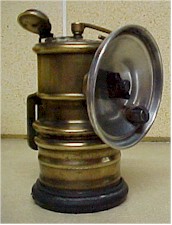The Carbide Lamp


In the early days the miner used a candle for light. He stuck a lump of yellow clay to the wall of the mine and stuck his candle in the clay.
A great invention was the carbide lamp. This lamp was clipped to the front of the miners helmet and afforded "hands free" light. It was an ingenious little contraption made up of two chambers. The lower chamber which screwed off from the upper one contained the small cubes of carbide which were like cubes of sugar. A pocket full of these would keep a miner going for a shift.
The upper chamber had a little lid on it and was filled with water. A tap protruded into the lower chamber from here. On top of the lid was a small handle for the tap which when turned on allowed a small flow of water into the lower chamber and on to the carbide. This fusion of water and carbide produced a gas which traveled up through the upper chamber and out through a nozzle on the front of the lamp.
The front of the lamp consisted of a shiny reflector, the nozzle and a small flint (similar to a cigarette lighter).
When the miner wanted light he turned on the tap and flicked the flint and out shot a burst of flame like a mini blow lamp.

The diagram above shows a cut-away view of the carbide lamp. The terms that
are defined can be matched with the diagram. The order represents the reaction
occurring inside the lamp when it is used. Note: parts with an asterisk by them
are not visible when the lamp is properly assembled.
Carbide Lamp Parts
- Water Door
- has small hinge, lifts up
- Water Chamber
- holds water
- Valve Control
- moves along grooves (control slots), sets rate of water flow
- Valve Stem
- tube that water flows down
- Water Valve
- hole where water drips onto carbide rocks
- Carbide Chamber
- holds carbide rocks, when mixed with water an acetylene gas is produced
- Felt Spring
- holds felt in place
- Felt
- allows gas to pass up from carbide chamber, keeps used (spent) carbide in chamber
- Felt Plate
- directs acetylene gas to...
- Gas Pipe
- tube that gas blows out of
- Burner Tip
- where flame is when lamp is in use
- Striker Assembly
- has flint rock inside, creates a spark, is attached to...
- Reflector
- magnifies amount of light, is held on by...
- Wing Nut
- holds on burner tip also
- Gasket
- rubber seal, prevents gas from leaking when lamp is assembled
- Hook
- holds lamp on helmet

Example of a Carbide Lamp and the box that it came in